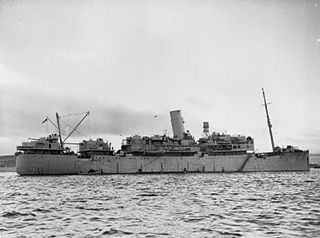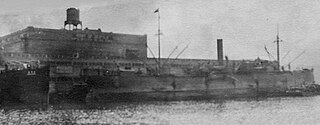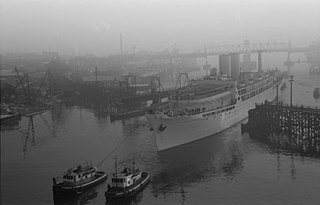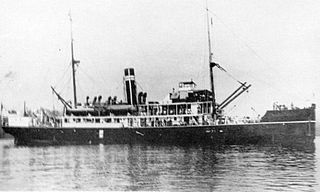
HMS Cheshire was a passenger ship that was built in Scotland in 1927 and scrapped in Wales in 1957. She belonged to Bibby Line, which ran passenger and cargo services between Rangoon in Burma and various ports in Great Britain, via the Suez Canal and Gibraltar. The Admiralty requisitioned her in 1939 and had her converted into an armed merchant cruiser (AMC). She was converted into a troopship in 1943, and returned to civilian service in 1948.

Ryusei Maru was a cargo steamship that was built in England in 1911 and sunk off the coast of Bali in 1944. Sit was launched as Bra-Kar for Fred. Olsen & Co. of Norway. In 1916 it changed owners and was renamed Havø. In 1935 it changed owners again and was renamed Mabuhay II.
SS Chenab was a steamship that was built in England in 1911 and scrapped in Scotland in 1953. For nearly two decades she was part of Nourse Line, which carried Girmityas from India to colonies in the Caribbean and the Pacific. In 1914 she was requisitioned for service in the First World War.

USS Argonne was a cargo steamship that was built in Japan in 1916 as Taifuku Maru No. 1. She served in the United States Navy from October 1918 to January 1919. In 1922 a French company bought her and renamed her Calonne. In 1922 an Italian company bought her and renamed her Wally. She was scrapped in Italy in 1935.

SS Clearton was a cargo steamship that was built in England in 1919 and sunk in the Battle of the Atlantic in 1940. The UK Shipping Controller ordered her, and she was built to War Standard design Type B. R Chapman and Sons of Newcastle upon Tyne operated her throughout her working life.

Shin'yō Maru was a cargo steamship that was built in 1894, had a fifty-year career under successive British, Australian, Chinese and Greek owners, was captured by Japan in the Second World War, and sunk by a United States Navy submarine in 1944.
Arpha was a 602 GRT passenger ferry built in 1900 as Canterbury for the South Eastern and Chatham Railway. She passed to the Southern Railway on 1 January 1923. She was sold to W E Guinness in 1926 and renamed Arpha. In 1938 she was sold to Sark Motorships Ltd, only to be requisitioned by the Royal Navy in 1939. Postwar, she was sold to Compania Shell de Venezuela and renamed Coriano. After a further change of ownership she was scrapped in 1955.

SS Polar Chief was a merchant steamship that was built in England in 1897 and scrapped in Scotland in 1952. In her 55-year career she had previously been called Montcalm, RFA Crenella, Crenella, Rey Alfonso, Anglo-Norse and Empire Chief. Early in the First World War she spent eight months pretending to be the battleship HMS Audacious.

USS Eastern Queen (ID–3406) was a cargo steamship. She was built in Japan in 1918 as Tofuku Maru, and bought that year by the United States Shipping Board (USSB), who renamed her Eastern Queen. From October 1918 to April 1919 she spent six months in the United States Navy as USS Eastern Queen, carrying cargo between the East Coast of the United States and France.

HMS Agamemnon was originally the Blue Funnel Line refrigerated cargo ship Agamemnon. She was built in 1929, traded between the UK and the Far East, and was scrapped in 1963. During the Second World War she was converted into an auxiliary minelayer in 1940, and then into an amenities ship in 1943.

HMS Menestheus was originally the Blue Funnel Line refrigerated cargo ship Menestheus. She was built in 1929, and traded between the UK and the Far East. She was an auxiliary minelayer from 1940 to 1943. In 1945, during the Second World War, she was converted into an amenities ship. She was scrapped in 1953 after being gutted by fire.

HMS Southern Prince was a motor ship that was built in 1929 as the refrigerated cargo ship Southern Prince. She was commissioned into the Royal Navy in 1940 as a minelayer. She became a headquarters ship and then an accommodation ship in 1944, was a fleet training ship in 1945, and returned to civilian trade in 1946. In 1947 she was sold to Italian owners who had her refitted as a passenger ship and renamed her Anna C. From 1952 she was a cruise ship. She was scrapped in 1972.
TSS City of Belfast was a passenger steamship that was built in England in 1893, renamed Nicolaos Togias in 1925, renamed Kephallinia in 1933 and sank in 1941. She was owned and registered in Britain until 1925, when she passed to Greek owners.

Bristol City was a British cargo steamship that was launched in 1919 and sunk in the Battle of the Atlantic in 1943. She was the third of five ships of that name owned by Bristol City Line.

SS Rio Tercero was a cargo steamship that was launched in England in 1912 as Eboe. She was renamed Fortunstella in 1938, and Rio Tercero in 1941. A U-boat sank her in the Battle of the Atlantic in 1942.

Tiger Hill was a Greek-owned steamship that was launched in Scotland in 1887 as Thrace. In 1910 she was renamed Thraki, and from 1916 to 1939 she underwent several changes of owner and name.
SS Macedonia was a steamship that was built in England in 1912, renamed Pincio in 1922 and scrapped in Italy in 1932. She was built as an ocean liner for Greek owners, but within months of being completed she was converted into an armed merchant cruiser for the Royal Hellenic Navy. An Ottoman warship sank her in 1913 in the First Balkan War.

SS Sir Harvey Adamson was a coastal passenger steamship that was built in Scotland in 1914 for the British India Steam Navigation Company (BI). She traded along the coast of Burma until 1947, shen she disappeared in a gale in the Andaman Sea. No survivor or identifiable wreckage was ever found.

SS Frankenwald was a passenger and cargo steamship that was launched in England in 1908 for Hamburg America Line. In 1919 France seized her as part of Germany's World War I reparations. In 1920 the Compagnie de Navigation Paquet bought her and renamed her Tadla. A Turkish shipowner bought her in 1934 and renamed her Tari. She passed through a succession of Turkish owners, and was scrapped in 1967.

Empire Mariner was a cargo steamship. She was built in Germany in 1922 for Hamburg America Line (HAPAG), who named her Schwarzwald. In 1935 H. Vogemann bought her and renamed her Rheingold. In October 1939 a Royal Navy cruiser captured her, and the United Kingdom government renamed her as the Empire ship Empire Mariner. She survived numerous transatlantic convoys in the Battle of the Atlantic. In 1946 South American Saint Line bought her and renamed her Saint Ina. In 1948 Bristol City Line bought her and renamed her Wells City. In 1951 the Pakistani-owned East & West Steamship Company bought her and renamed her Fausta. She was scrapped in Pakistan in 1964.
















